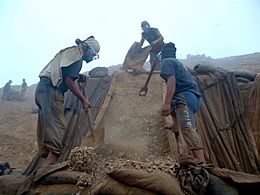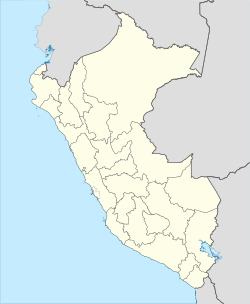Guañape Islands facts for kids
|
Islas Guañape (Spanish)
|
|
|---|---|

Workers collecting guano at Guañape Norte Island.
|
|
| Geography | |
| Location | Pacific Ocean |
| Coordinates | 8°32′41″S 78°57′49″W / 8.54472°S 78.96361°W |
| Major islands |
|
| Area | 0.6273 km2 (0.2422 sq mi) |
| Highest elevation | 143 m (469 ft) |
| Administration | |
| Region | La Libertad |
| Additional information | |
| Time zone |
|
The Guañape Islands are a group of islands found off the northern coast of Peru. This group includes four islands: Isla Guañape Norte, Isla Guañape Sur, Islotes Cantores, and Islotes Los Leones.
These islands are very important. They are home to many birds that eat fish from the ocean. These birds include white-breasted cormorants, grey pelicans, and white-headed gannets. Over thousands of years, their droppings, called guano, have piled up. Some islands have guano layers that are 100 to 150 feet thick! It's thought that about a million birds can live on one island. They can produce over 1,000 tonnes of guano every year.
Contents
Why is Peruvian Guano Special?
The weather along the coast of Peru is very special. This makes Peruvian guano the best for farming. A cold ocean current, called the Humboldt Current, flows along Peru's coast. This cold water stops rain from falling on the islands.
Because there is no rain and the weather is warm, the guano dries naturally. This drying process keeps important nutrients, like nitrates, from disappearing. These nutrients are what make guano such a great fertilizer. Also, the birds that make guano eat a lot of fish. This makes their droppings extra rich in nutrients. The birds are also quite safe from predators on these islands. This means their numbers can grow large.
Guano in History
Long before Christopher Columbus sailed to America, the Incas knew how valuable guano was. They used it to help their crops grow. Guano was so important that the Incan government had strict rules about it. They divided the islands where guano was found among different areas. They also told people exactly when and how to collect the guano. Incan law even said that harming or disturbing the birds that made guano was a crime punishable by death. This shows how much they valued these birds and their guano.
Guano and People
In the early 1800s, people from Europe visited the Guañape Islands. They brought some guano back to Europe. They soon realized how useful it was for making plants grow better. Over the next 45 years, Peru started selling a lot of guano to other countries. It became a very important product for Peru.
In the 1900s, people started making artificial fertilizers. These new fertilizers began to replace guano. This change affected Peru's economy. Also, things like ocean warming and El Niño can harm the ocean's ecosystem. This means fewer fish for the birds to eat. When there are fewer fish, there are fewer birds. This leads to less guano being made, which can also affect Peru's economy.
Protecting the Islands
The Guañape Islands belong to Peru. They are a natural source of excellent fertilizer. The Peruvian government works hard to protect the guano reserves. They want to make sure there is always enough guano. To do this, they make sure the islands and the birds living there are safe and well cared for. This helps keep the bird populations healthy.
See also
 In Spanish: Islas Guañape para niños
In Spanish: Islas Guañape para niños


